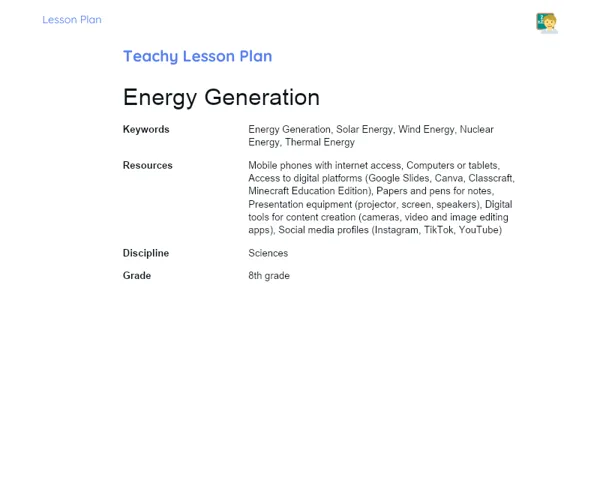Lesson Plan | Lesson Plan Tradisional | Positions of the Sun and Shadow
| Keywords | Earth Movement, Rotation, Day and Night, Sun Position, Shadow, Shadow Changes, Observation, Visual Examples, Practice |
| Resources | Globe, Images or diagrams illustrating Earth's rotation, Objects for shadow observation (e.g., trees, buildings), Outdoor area (schoolyard), Pencil and paper for notes, Whiteboard and markers |
Objectives
Duration: (10 - 15 minutes)
This stage aims to provide a straightforward overview of the objectives for the lesson. It will serve as a guiding tool for both teachers and learners regarding the content we’ll cover, ensuring everyone grasps the focus and skills to be developed during the lesson.
Objectives Utama:
1. Understand that the Earth spins on its axis, leading to the change between day and night.
2. Identify how the Earth's spin affects the sun's position in the sky across the day.
3. Observe and discuss how shadows vary in position and size throughout the day.
Introduction
Duration: (10 - 15 minutes)
The aim of this stage is to grab the learners' attention and set the scene by using relatable daily experiences. By clearly presenting the context, students will be more engaged and eager to understand the reasons behind the changes in shadows throughout the day.
Did you know?
Did you know that shadows shift position and size as the day goes on thanks to the Earth's continual rotation? This means that while it seems like the sun is moving across the sky, it’s actually the Earth doing the spinning! That's why a tree's shadow can be in one spot in the morning and move to a completely different location by the afternoon!
Contextualization
Begin the lesson by informing the learners that daily, the sun's location in the sky changes, which in turn causes shadows to move and fluctuate in size. Ask them if they've noticed how the shadow of a tree or a building can become longer or shorter at different times of the day. Clarify that this phenomenon occurs because of the Earth's rotation.
Concepts
Duration: (40 - 45 minutes)
The goal of this stage is to deepen learners' understanding of the Earth's rotation and its impact on the sun's position and shadows throughout the day. By tackling specific topics and offering visual and practical examples, students will gain a clearer comprehension of these phenomena. The suggested questions will aid in reinforcing learning and evaluating students' grasp of the content.
Relevant Topics
1. Earth's Rotational Movement: Explain that the Earth spins on its axis. Use a globe to illustrate this. Emphasise that it takes roughly 24 hours to complete one rotation, which causes the transition between day and night.
2. Position of the Sun in the Sky: Describe how the sun's height in the sky shifts during the day because of Earth's rotation. Use images or diagrams to depict the path of the sun from sunrise to sunset.
3. Shadow Changes: Discuss how shadows alter in position and size throughout the day. Show real-life examples and encourage learners to observe the shadows of objects around the classroom or outside. Explain how shadows in the morning and late afternoon are longer, while at noon, when the sun is at its peak, shadows are much shorter.
To Reinforce Learning
1. What causes the changes in a shadow’s position and size throughout the day?
2. What leads to the shift from day to night on Earth?
3. In what ways does the sun's height in the sky affect the size of shadows?
Feedback
Duration: (25 - 30 minutes)
This time aims to review and cement the knowledge learners have gained during the lesson. By raising the questions discussed, the teacher has the opportunity to clarify misconceptions and reinforce key ideas. Furthermore, engaging learners in discussions and additional questions stimulates critical thinking and practical application of their new understanding.
Diskusi Concepts
1. Clarify that shadows shift in position and size over the course of the day due to the Earth's spinning. As the Earth rotates, the sun's location in the sky appears to vary, leading to changes in shadows. In the morning, when the sun is low, shadows are long; around noon, when the sun is high, shadows are short; and in the afternoon, shadows lengthen again as the sun descends. 2. Explain that the daily cycle of day and night stems from the Earth's own rotation. When one side of the Earth faces the sun, it's daytime there. When it turns away from the sun, night falls. 3. Discuss how the sun's position in the sky affects shadow sizes. Low sun positions in the morning and late afternoon mean longer shadows due to sunlight hitting at a slant, while high noon sun creates shorter shadows as sunlight illuminates the ground nearly directly.
Engaging Students
1. Why do you think shadows change size throughout the day? Can you share an example you've noticed? 2. How would you describe to a mate why we experience day and night? 3. If you were a scientist watching shadows change throughout the day, what would you expect to observe? Why? 4. In what ways do you think understanding shadows is helpful in our everyday lives?
Conclusion
Duration: (10 - 15 minutes)
The aim of this stage is to summarise and reinforce the key points discussed in the lesson, ensuring students thoroughly understand the content. More so, by underscoring the practical relevance of the topic, learners will appreciate how what they've learned applies to their daily lives, making the overall educational experience more engaging.
Summary
['The Earth spins on its axis in a movement called rotation, taking about 24 hours and causing the day-night cycle.', "The sun's position in the sky changes due to the Earth's spin, which causes shadows to alter in both position and size.", 'In the morning and late afternoon, shadows stretch longer because the sun is lower in the sky, while at midday, they become shorter as the sun rises higher.']
Connection
The lesson connected theory to practical experience by using visual aids and hands-on examples, such as observing shadows in the classroom or outdoors. This allowed learners to gain a concrete understanding of how the Earth's rotational movement shapes the sun's position and shadows throughout the day.
Theme Relevance
Grasping the way shadows change is crucial for everyday tasks, like figuring out the best spot to plant a tree or plan a home layout, and even for leisure activities like enjoying a sunny day at the park. This curiosity about Earth's motions and their effects also encourages scientific inquiry and observation of nature.



